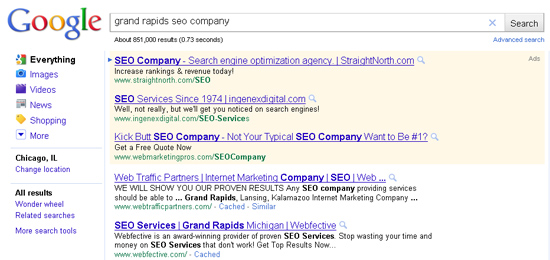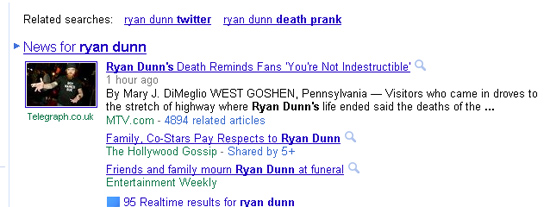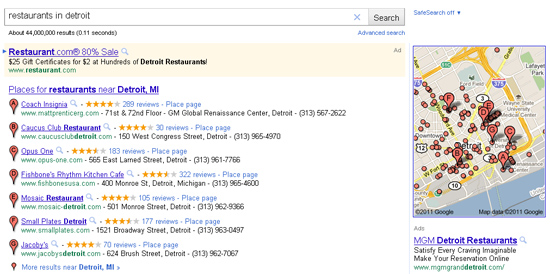Last Updated on May 13, 2022 by admin
Remember when you could just type in what you wanted on Google and your results were merely a combination of Adwords ads and ten links with a couple lines of description? You know, when Google looked like this:

Remember those days? Everything was made of words and you knew that Google was just doing its best to figure out what you wanted and serve you up the best info they could? Well, apparently that wasn’t good enough.

Now you do the same search that you always did and there are video results, local results, shopping results, Twitter results, individual profiles, pictures, and news. Not only that, it seems like if you do a search on one computer to the next that even normal looking searches give you different results. What the hell happened? What kind of drugs have the folks over in Mountain View been feeding their search engine?
Well, there are a lot of things influencing search listings these days, and since we get a lot of questions about this, I figured I’d try to do a quickie to shed some light on the different types of integrated results and why they’re showing up in your results.
My friends are telling Google what to do?
One of the newest changes to Google is integrating aggressively into SERPs is social proof, or recommendations from people they know you’re connected with. Google has data, and if they know who you are, they’ll know who you’re connected with on Twitter, Facebook and more. So if you have a lot of friends on such social networks, you’ll likely see more and more results like this – where Google essentially re-ranks based on recommendations from your friends assuming you’ll be interested in similar things.

So even if you don’t spend a ton of time on Twitter, Google will be serving you up things that your friends have been sharing. Personally, I kind of like this since I don’t keep up as much as I should on my Twitter feed. Intermittently, Google has also been adding Twitter feeds to search results, but this has been a bit scattershot so far and I’d guess this new model will likely be the go-to method going forward due to the more relevant nature of using a Googler’s known personal network.
If you’re people searching, you’ll also see that Google is yanking in profiles from social media sites like LinkedIn, Google Profiles, Twitter, Facebook and more…so if you have unflattering profile pictures, make sure you’re hiding them. Just because grandma doesn’t use Facebook, Twitter or LinkedIn doesn’t mean she won’t Google you…

Pictures, Video and News
These are the old guard. You’re used to seeing these. Especially for hot news items (Ryan Dunn of Jackass fame died this past week) Google has long been adding news results for these trending items. Lots of recent activity in news outlets will give you something like this (though I don’t recommend death as a way to gain rankings and/or traffic):

Beyond that, video and image results are most likely integrated from internal Google data – when search results trigger a higher than usual proportion of video and image searches (and higher than usual click through rates) they are likely promoted and if click through remains high in integrated search, they will likely continue to rank well. Ranking within these various categories are a whole issue unto themselves, and if you want to look into it there are some great sites and posts out there focusing specifically on video SEO and image SEO like ReelSEO and this post from Top Rank.
So I’ve got maps and local reviews. Why? What if I don’t want them?
The last year has led to a lot of experimentation in localized results. You probably got used to the “seven pack” results as we search marketers like to call them – a map integrated into your search results with the first seven listings. You know, this little thing:

More recently, Google has been pushing the map results to the right hand adwords column to offer more Places page information in the center column, integrating information culled from review sites to help you make an informed click before you have to make an informed decision.

These results have also been around for a while, and Google continues to get smarter about which results most likely warrant these types of results. Because, let’s be honest, if you’re searching for “grocery store” one in Timbuktu that’s done a nice job with SEO probably isn’t going to be much value for the folks in Chesaning, Michigan (though there’s only one grocery store there).
If you want to learn about the factors that influence local results, the best source on the web can be found at David Mihm’s site.
If you want Google’s unfiltered results, it’s not easy to get them anymore. In some ways Google is either personalizing your results from your account (assuming you’re logged in), your IP address, cookies or any other information they are able to obtain from you. But sometimes you really don’t want your results influenced by your locality (maybe you DO want to know what the ten best SEO’d grocery stores are), your friends, your search history or other influencing factors. If you want untouched, unpersonalized Google, it may not even be possible, but our recent post on personalized Google results as well as this more comprehensive one from SEOmoz should give you plenty of tools to get you close.
I think I have exhausted my allotted number of Google references and screenshots for the day. Can we talk about something else now? How about the Blekko Zorro update?
Related articles
- How Google Caffeine Will Affect Rankings (organicseoconsultant.com)
- Social media now directly influences search rankings (christopherspenn.com)

Leave a Reply